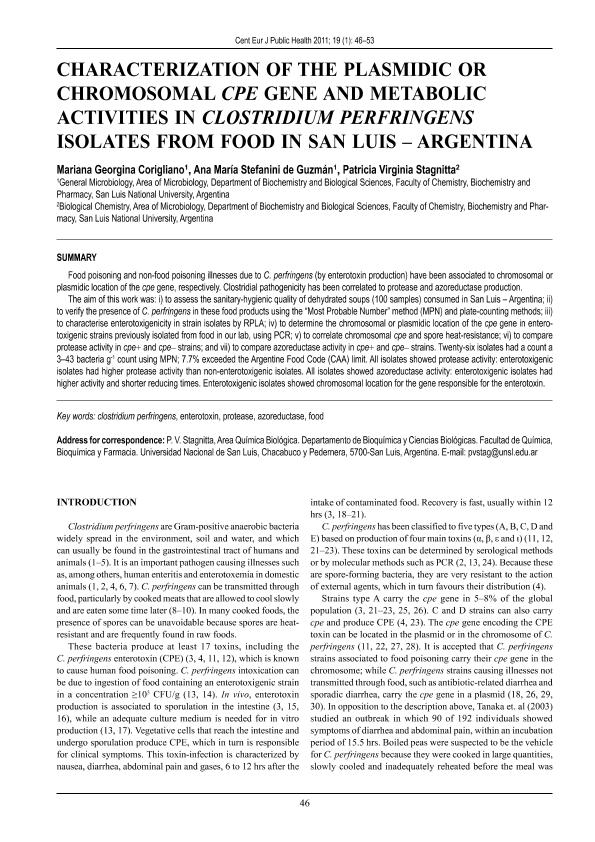Artículo
Characterization of the Plasmidic or Chromosomal cpe Gene and Metabolic Activities in Clostridium perfringens Isolates from Food in San Luis - Argentina
Fecha de publicación:
03/2011
Editorial:
National Institute of Public Health
Revista:
Central European Journal of Public Health
ISSN:
1803-1048
Idioma:
Inglés
Tipo de recurso:
Artículo publicado
Clasificación temática:
Resumen
Food poisoning and non-food poisoning illnesses due to C. perfringens (by enterotoxin production) have been associated to chromosomal or plasmidic location of the cpe gene, respectively. Clostridial pathogenicity has been correlated to protease and azoreductase production.The aim of this work was: i) to assess the sanitary-hygienic quality of dehydrated soups (100 samples) consumed in San Luis – Argentina; ii) to verify the presence of C. perfringens in these food products using the "Most Probable Number" method (MPN) and plate-counting methods; iii) to characterise enterotoxigenicity in strain isolates by RPLA; iv) to determine the chromosomal or plasmidic location of the cpe gene in enterotoxigenic strains previously isolated from food in our lab, using PCR; v) to correlate chromosomal cpe and spore heat-resistance; vi) to compare protease activity in cpe+ and cpe– strains; and vii) to compare azoreductase activity in cpe+ and cpe– strains. Twenty-six isolates had a count a 3–43 bacteria g-1 count using MPN; 7.7% exceeded the Argentine Food Code (CAA) limit. All isolates showed protease activity: enterotoxigenic isolates had higher protease activity than non-enterotoxigenic isolates. All isolates showed azoreductase activity: enterotoxigenic isolates had higher activity and shorter reducing times. Enterotoxigenic isolates showed chromosomal location for the gene responsible for the enterotoxin.
Palabras clave:
ENTEROTOXIN
,
PROTEASE
,
AZOREDUCTASE
,
food
,
clostridium perfringens
Archivos asociados
Licencia
Identificadores
Colecciones
Articulos(IIB-INTECH)
Articulos de INST.DE INVEST.BIOTECNOLOGICAS - INSTITUTO TECNOLOGICO CHASCOMUS
Articulos de INST.DE INVEST.BIOTECNOLOGICAS - INSTITUTO TECNOLOGICO CHASCOMUS
Citación
Corigliano, Mariana Georgina; de Guzmán, Ana María Stefanini; Stagnitta, Patricia Virginia; Characterization of the Plasmidic or Chromosomal cpe Gene and Metabolic Activities in Clostridium perfringens Isolates from Food in San Luis - Argentina; National Institute of Public Health; Central European Journal of Public Health; 19; 1; 3-2011; 46-53
Compartir
Altmétricas




